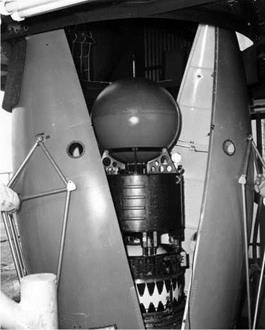BK14
Two stage. Launched 9 May 1961 at 21:37. Apogee 258 miles.
BK14 was another two-stage vehicle with second stage and head similar to that of BK08. The initiation of the second stage light-up was to be by means of a Phillips ionisation gauge as on BK09. Upper atmosphere experiments carried out
 were a cosmic ray scintillation counter and electron temperature measurement.
were a cosmic ray scintillation counter and electron temperature measurement.
The supply of kerosene ran out early, at 128 seconds, and this was followed by 14 seconds of ‘cold’ burning (i. e. HTP only). The final shut-down occurred at the correct time. Subsequent analysis of records indicated that a leak had developed in the kerosene supply system which accounted for the excessive kerosene flow rate.
Initiation of second stage separation was dependent on the operation of an inertia switch, and as a result of a drop in first stage performance, associated with cold burning, the acceleration was not high enough to operate the switch. Because of this, events following burnout, such as second stage separation, spin, ignition, head
separation and recording did not take
place. Had the second stage operated, the resultant re-entry velocity would have been adequate for a satisfactory experiment.
In view of this, alternative methods for arming second stage separation, not dependent on first stage performance, were subsequently employed.











 The cause of the failure of R0 was relatively simple, but it was decided to repeat the flight, so that the R1 launch was an exact repeat of R0. This time the vehicle behaved exactly as intended.
The cause of the failure of R0 was relatively simple, but it was decided to repeat the flight, so that the R1 launch was an exact repeat of R0. This time the vehicle behaved exactly as intended.